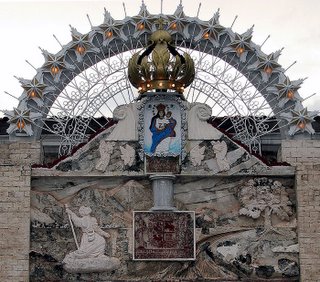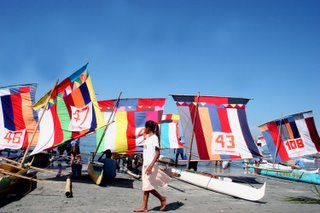 The century-old shrine of the Virgin Mary in the former Spanish garrison called Fort Pilar in Zamboanga City. (Zamboanga Journal)
The century-old shrine of the Virgin Mary in the former Spanish garrison called Fort Pilar in Zamboanga City. (Zamboanga Journal)  Colorful sails the locals call vinta in Zamboanga City. (Zamboanga Journal)
Colorful sails the locals call vinta in Zamboanga City. (Zamboanga Journal)
 Children play on a public square named after U.S. General John J. Pershing in Zamboanga City.(Zamboanga Journal)
Children play on a public square named after U.S. General John J. Pershing in Zamboanga City.(Zamboanga Journal)
A girl walk by the beach lined up with vintas in Zamboanga City. (Zamboanga Journal)
The City of Flowers
ZAMBOANGA
Quetal Ustedes? From the moment you hear those lifting words, you realize it’s true. Here indeed is a quaint pocket of history torn from mainland Spain. A place unlike any other in the Philippines.
While Spain’s three-century reign left its indelible imprint on the country, nowhere was its legacy perhaps so concentrated and embedded than in Zamboanga, which took for its native tongue, Chavacano, the delightful mix of 60% Español and 40% native dialects.
There is more to Zamboanga than this. As far back as the 13th and 14th centuries, it was already a trading center with a vibrant culture of its own, emblazoned against the horizon in the vivid colors of the native vinta sails that fluttered gaily off its shores.
And when the Castillan flag of Spain first appeared in the horizon off Caldera Bay (now Recodo) in 1593, Zamboanga opened another epoch in its colorful heritage, one that would leave a legacy so rooted that from it would spring much of the city’s romance and allure.
The best recuerdo of la presencia de España in Zamboanga was and remains to be the Fort Pilar, the coastal garrison built in 1635 around which the city first grew.
In time, it became a shrine to Nuestra Señora del Pilar de Zaragoza, especially after miracles that are now part of legends and Zamboanga folklore.
It was in Zamboanga that Christianity gained a foothold in Mindanao. The Archdiocese of Zamboanga covered all of Mindanao, except Sulu where Islam and the Tausug culture proved every bit as dynamic as Spain’s influence.
Zamboanga City is located on the tip of the Zamboanga peninsula on the bottom of Mindanao island in southern Philippines. It has about 142,000 hectares of sloping terrain from a surrounding shoreline of coral beaches to mineral-rich mountains in the center of the peninsula.
Zamboanga City has at least 25 island communities and 98 villages called barangays. The city has more than 600,000 people.
Chavacano is the dominant language in Zamboanga City. Other dialects like Bisaya and the Muslim vernaculars are also spoken in certain communities in the city. The locals are friendly and can speak English. Zamboanga is famous for its fresh seafoods, and crabs called Curachas.
The food is considered as one of the best in the country. And the exotic Muslim food is similarly popular because of its traditional hot spices and herbs use in cooking.
Zamboanga City enjoys a location that is free from the typhoon belt area. March to May is hot and dry, with temperature at 22 degrees Celsius. June to October is rainy. November to February is cool, with temperatures ranging from 22 degrees Celsius to 28 degrees Celsius. Average humidity year-round is 77%.
Zamboanga is one of the centers of Western Mindanao for commerce and trade, government and finance, transportation and communication.
It has an international airport, a huge sea port area, and the Zamboanga Freeport and Economic Zone Authority. It is known as the "Sardine" capital of the Philippines because most of the sardine and canning factories are situated in Zamboanga City.
It has been involved in the export of marine and aquaculture products, fruits, processed food, furniture and wood products, and many more.
There are dozens of god hotels and inns in Zamboanga City. Internet shops are many and telecommunication is not a problem. Transportation is easy around Zamboanga with motorcycle taxis and jeeps all over.
There are few tourist areas in Zamboanga City, but it is very rich in culture and heritage, and has lots of historical information to offer its visitors.
(Zamboanga Journal/Department of Tourism)

2 comments:
Hi Ketal. This is a cool new blog from our hometown. I am also blogging from this city. Visit my site at
http://citizenonmars.blogsome.com
Gracias Con Todos...
Major Tom,
Congrats pala huh!
Wow, what a site! There are so much information dude, and a lot of work, and work and work, just to be able to come up and maintain such site.
Mabuhay!
From the City of Flowers, Zamboanga
Al Jacinto
Post a Comment